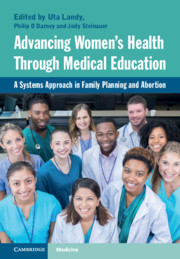 Advancing Women's Health Through Medical Education
Advancing Women's Health Through Medical Education National and Global Advances for Availability, Accessibility and Quality
from Section IV - Reproductive Health Services & Abortion Training: Global Examples
Published online by Cambridge University Press: 30 July 2021
Over the past 30 years, a number of national and international commission reports focus on the future of the health workforce related to availability, accessibility, acceptability and quality factors of human resources for health. Specific to a sexual and reproductive health (SRH) workforce, the World Health Organization (WHO) provides leadership for delivery of essential SRH care by competent health workers around the world. According to the WHO, SRH care goes beyond maternal child health care to include the SRH of men and women throughout their life-cycle, and adolescents of both sexes delivered as integrated services within a primary care system. SRH extends before and beyond the years of reproduction, and it is closely associated with sociocultural factors, gender roles and the protection of human rights. Global and national examples, like the US Ryan Residency Training and Family Planning Fellowship programs, described elsewhere in this book, highlight the policy interventions to align SRH practice, education, and credentialing to address challenges and progress to improving SRH workforce capacity.
To save this book to your Kindle, first ensure no-reply@cambridge.org is added to your Approved Personal Document E-mail List under your Personal Document Settings on the Manage Your Content and Devices page of your Amazon account. Then enter the ‘name’ part of your Kindle email address below. Find out more about saving to your Kindle.
Note you can select to save to either the @free.kindle.com or @kindle.com variations. ‘@free.kindle.com’ emails are free but can only be saved to your device when it is connected to wi-fi. ‘@kindle.com’ emails can be delivered even when you are not connected to wi-fi, but note that service fees apply.
Find out more about the Kindle Personal Document Service.
To save content items to your account, please confirm that you agree to abide by our usage policies. If this is the first time you use this feature, you will be asked to authorise Cambridge Core to connect with your account. Find out more about saving content to Dropbox.
To save content items to your account, please confirm that you agree to abide by our usage policies. If this is the first time you use this feature, you will be asked to authorise Cambridge Core to connect with your account. Find out more about saving content to Google Drive.